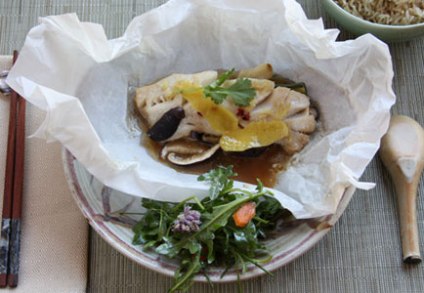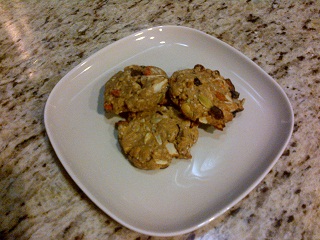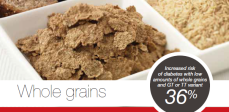With the popularity of low-carb and “paleo” type diets, I’ve often gotten this response from clients who (like me) have the elevated risk variant of the TCF7L2 gene:
“I don’t eat grains/breads/cereals, so I don’t have to worry about my elevated risk.”
However, while grains are a carbohydrates, we also get carbohydrates from fruit, vegetables and some dairy porducts. For those who choose not to eat grains and have the elevated risk variant of the TCF7L2 (as determined in Nutrigneomix testing), it is still important to address the glycemic index or load of your diet to reduce your risk of developing type 2 diabetes.
So what is glycemic index? What about glycemic load? How does one eat a low glycemic diet?
Both glycemic load and glycemic index are measures of the “quality” of carbohydrates in food.
The glycemic index (GI) is a ranking of carbohydrates on a scale from 0 to 100 according to the extent to which they raise blood sugar levels after eating. Foods with a high GI are those which are rapidly digested and absorbed and result in marked fluctuations in blood sugar levels. Low-GI foods, by virtue of their slow digestion and absorption, produce gradual rises in blood sugar and insulin levels, and have proven benefits for health. (http://www.glycemicindex.com/about.php)
The difference between glycemic load and index is that the glycemic load takes into account the typical serving size of a given food.
For several reasons, including the greater availability of glycemic index measures, I usually speak to the glycemic index of foods. So for those with the elevated risk variant of TCF7L2, it is very important to eat a low glycemic diet.
Foods are often categorized as low, medium or high on the glycemic index depending on how much they raise blood sugar levels as compared to a “standard”, usually sucrose, which is assigned a value of 100.
Low 0 – 55
Moderate 56 – 69
High 70 or more
I often refer to the University of Australia searchable database at http://www.glycemicindex.com/foodSearch.php to look up foods as the database lists the GI, grams of carbohydrates per serving and GL for thousands of foods. You can even choose ‘Canada’ in the drop down list to view Canadian products. Note that foods like meat and eggs have negligible amounts of carbohydrates and are therefore not listed in the database.
Here are some tips to lower the glycemic impact of the food you eat:
1. Choose whole, unprocessed versions of fruit, vegetables and grains.
2. Choose less ripe fruit.
3. Cook grains and potatoes “al dente”, or slightly chewy instead of over-cooking.
4. Pair higher glycemic foods (fruit, some grains, potatoes) with lower glycemic foods such as proteins and high-fibre vegetables to lower the overall glycemic impact of your meal or snack.
Here is a yummy, low GI way of getting in healthy carbohydrates for those who choose not to eat grains. This recipe is also high in folate (lentils) and omega-3 fats (salmon) for those who have the elevated risk gene variant for these nutrients.
Salmon with Lentil Pilaf
Makes 4 serving(s)
Ingredients
- 4 salmon fillets, (about 6 oz/175 g each)
- 2 tbsp (30 mL) olive oil
- 1/4 tsp (1 mL) salt
- 1/4 tsp (1 mL) pepper
- 1 1tbsp (15 mL) fresh mint or fresh parsley, chopped
- Lentil Pilaf:
- 1 tbsp(15 mL) olive oil
- 1 onion, chopped
- 1 stalk celery, chopped
- 2 cloves garlic, minced
- 1 sweet red pepper, diced
- 1tsp (5 mL) ground cumin
- 1/4 tsp (1 mL) salt
- 1 cup(250 mL) brown lentils or green lentils
- 2 cups (500 mL) chicken stock
- 2 tbsp (30 mL) fresh mint or fresh parsley, chopped
Preparation:
In saucepan, heat oil over medium heat; fry onion, celery, garlic, red pepper, cumin and salt until onion is softened, about 5 minutes. Add lentils; stir to coat. Add stock; bring to boil. Reduce heat, cover and simmer until lentils are tender and some liquid remains, about 40 minutes. Stir in mint.
Meanwhile, place salmon fillets on parchment paper-lined or greased baking sheet. Brush oil over salmon; sprinkle with salt and pepper. Roast in 425°F (220°C) oven until fish flakes easily when tested, about 12 minutes. Sprinkle with mint.
Arrange lentil pilaf on 4 warmed plates; top with salmon.
Nutritional Info |
|
| Per serving: about | – |
| cal | 570 cal |
| pro | 45 g |
| total fat | 28 g |
| sat. fat | 4 g |
| carb | 34 g |
| fibre | 7 g |
| chol | 84 mg |
| sodium | 770 mg |
| % RDI: | – |
| calcium | 7% |
| iron | 44% |
| vit A | 14% |
| vit C | 97% |
| folate | 142% |
Modified from: http://www.canadianliving.com/food/salmon_with_lentil_pilaf.php




